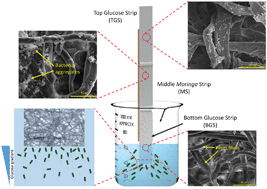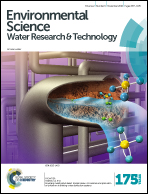Fishing, trapping and killing of Escherichia coli (E. coli) in potable water†
Abstract
An innovative process of effective ‘fishing, trapping and killing’ of Escherichia coli (E. coli) in contaminated water samples using paper strips is proposed here. A naturally occurring sugar, D-glucose, has been adsorbed onto blotting paper strips to facilitate the ‘fishing’ of E. coli cells by inducing their chemotactic response towards the chemoattractant (glucose) concentration gradient. By dipping paper strips laced with 0.1 M glucose in contaminated water samples, we report a maximum bacterial removal efficiency of 99.5% after a 90 minute duration. The porous nature of the paper strip facilitates the ‘trapping’ of the bacterial cells within its inherent porous network. Antimicrobial paper strips produced through the adsorption of bactericidal Moringa oleifera cationic protein (MOCP) were used to ‘kill’ the ‘trapped’ E. coli through prolonged contact. Finally, we have combined these individual processes into an integrated ‘fishing, trapping, and killing’ water treatment system, whereby the top and the bottom paper strips containing chemoattractant glucose are glued with the middle one containing the antimicrobial MOCP. Based on the results of the study, we anticipate that this approach can lead to the development of a new generation of inexpensive and portable water treatment devices which can passively remove and neutralize deleterious bacteria from water.


 Please wait while we load your content...
Please wait while we load your content...